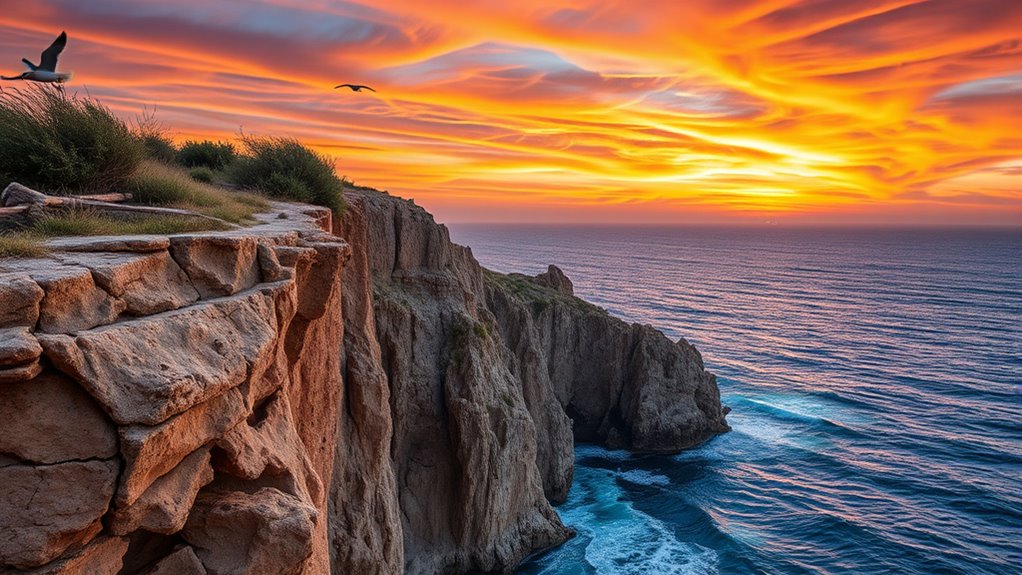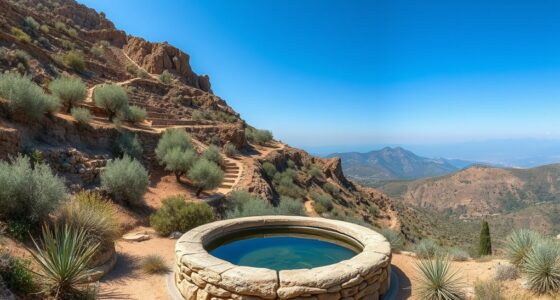Climate change is vastly impacting Sardinia’s coasts, causing sea levels to rise and leading to shoreline erosion along the island’s sandy beaches. This threatens local ecosystems, marine life, and the tourism industry, which relies heavily on pristine beaches. Rising temperatures and extreme weather also harm biodiversity and intensify habitat loss. Human activities exacerbate these issues by disrupting natural sediment flow and coast protection. If you keep exploring, you’ll discover effective strategies to protect Sardinia’s coastal future.
Key Takeaways
- Sardinian coasts are experiencing significant erosion, with coastline loss of about 107 km due to rising sea levels.
- Sea level in the Mediterranean is rising nearly three times faster than previously estimated, increasing coastal vulnerability.
- Higher temperatures and storms threaten marine biodiversity, including coral bleaching and declines in native fish species.
- Human activities like construction and upstream damming disrupt sediment flow, exacerbating shoreline erosion.
- Climate change impacts threaten Sardinia’s tourism sector, causing decreased visitor numbers and economic instability.
Rising Sea Levels and Shoreline Retreat in Sardinia
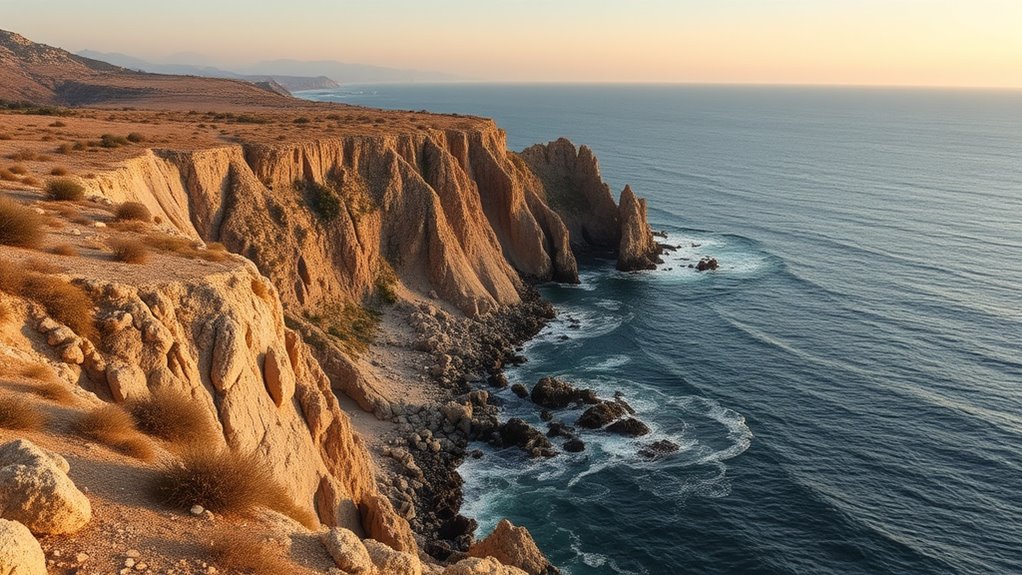
Rising sea levels are already reshaping Sardinia’s coastline, driven by accelerated global warming and local land subsidence. The Mediterranean sea level is rising nearly three times faster than previously thought, putting Sardinian shores at increased risk. Over the past 40-50 years, the island has lost about 107 km of coastline, with erosion affecting around 165 km of sandy shores. Storms, stronger waves, and shifting winds accelerate shoreline retreat, especially along the north and northwest coasts. By 2100, sea levels could rise about 0.31 meters, intensifying erosion and causing saltwater intrusion into freshwater sources like the Coghinas valley. Land subsidence, combined with natural and human factors, worsens relative sea level rise, leading to more significant coastal erosion, threatening habitats, infrastructure, and coastal communities. Additionally, the rate of sea level rise in the Mediterranean is expected to increase further, amplifying these impacts and complicating mitigation efforts.
Economic Risks for Sardinian Tourism Industry
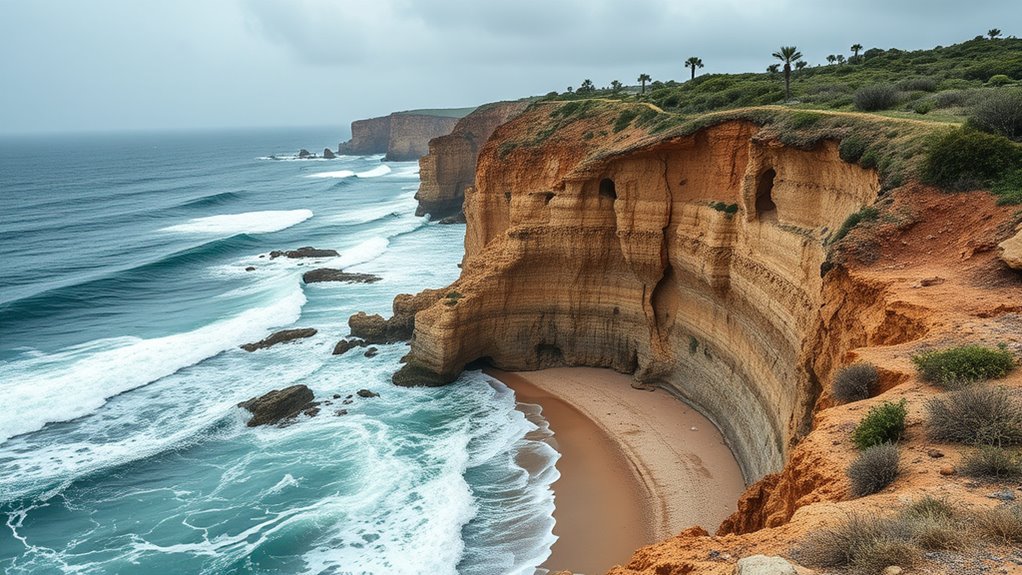
Climate change poses significant economic risks to Sardinia’s tourism industry, especially as increasing temperatures and extreme weather events disrupt visitor patterns and infrastructure. Hotter summers lead to declines in tourist arrivals during peak season, as extreme heat deters visitors, reducing daily spending and length of stays at coastal resorts. While shoulder seasons may see some growth due to warmer weather, it doesn’t fully offset summer losses. Water scarcity further raises operational costs for hotels, restaurants, and leisure providers, impacting amenities and hygiene. Decreased tourist demand results in job losses, higher unemployment, and economic instability for local businesses. Additionally, climate-induced damage like beach erosion and storm damage diminishes Sardinia’s appeal, undermining its competitive advantage and risking long-term tourism sustainability.
Threats to Marine and Terrestrial Biodiversity
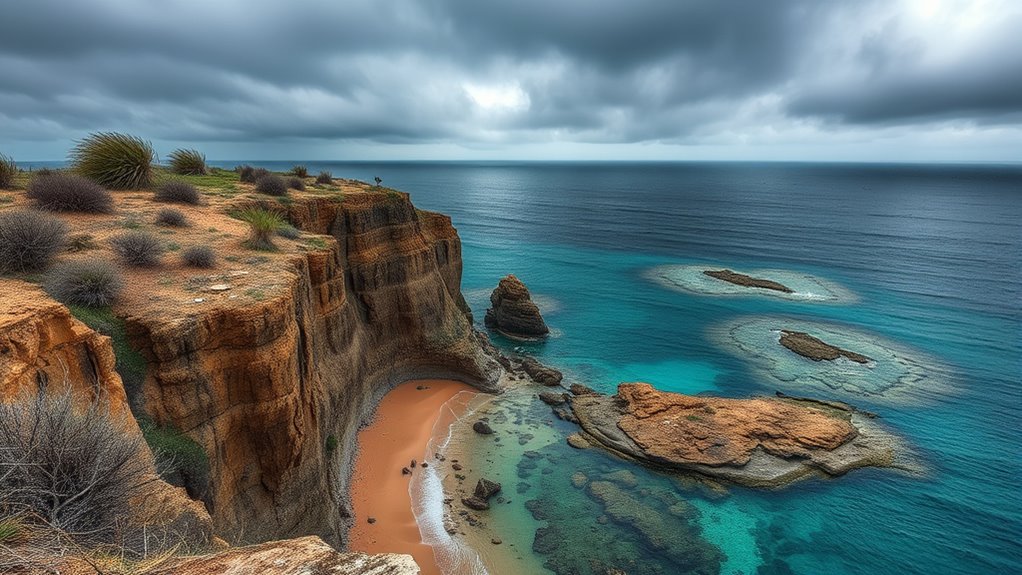
As waters around Sardinia warm, marine ecosystems face increasing stress, threatening their biodiversity. Rising temperatures cause coral bleaching near Grotta di Nereo, Riviera del Corallo, and Spiaggia di Rena Bianca, damaging habitats essential for many marine species. Fish diversity declines as invasive species thrive in warmer waters, disrupting ecological balance and harming local fisheries. On land, prolonged droughts weaken cork oak forests, making them more susceptible to pests and diseases, which accelerates habitat loss. Endemic species, including ancient mesophytes and native mammals like the Sardinian wildcat, face declining populations due to habitat degradation. Desertification intensifies, reducing suitable habitats for terrestrial flora and fauna. Sea level rise further threatens coastal habitats and nesting sites for seabirds and marine turtles. Additionally, the loss of habitat diversity reduces the resilience of ecosystems to climate change impacts. Overall, climate-induced stresses threaten Sardinia’s rich biodiversity, demanding urgent conservation efforts to protect these vulnerable ecosystems from irreversible damage.
Human Activities and Sediment Disruption
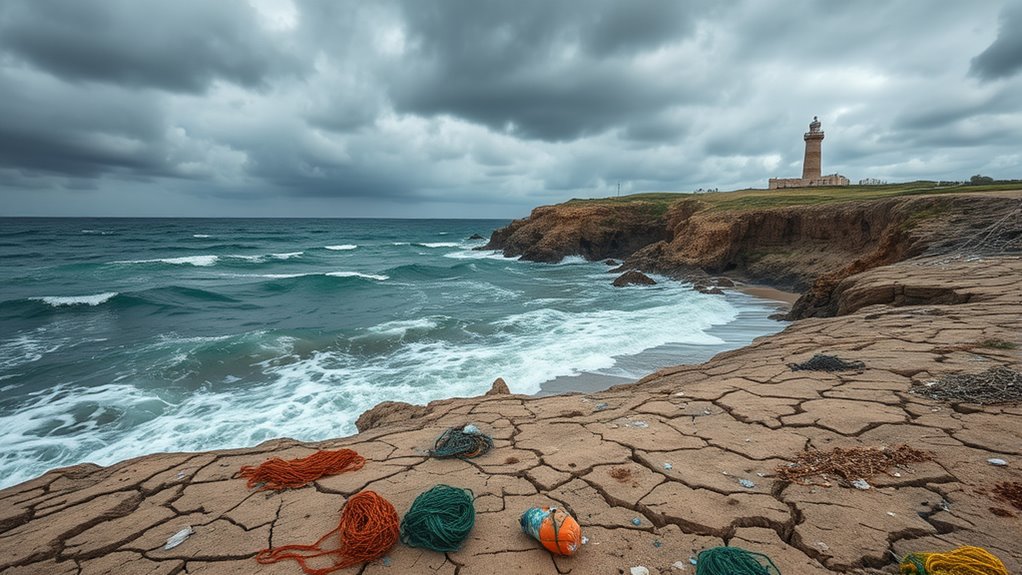
Human activities have profoundly disrupted sediment flow along Sardinia’s coastlines, primarily through construction and land use changes. Extensive artificial coastlines from tourism, industry, and transport infrastructure replace natural shorelines, disrupting sediment dynamics and accelerating erosion. Urbanization and physical modifications interfere with natural processes like beach formation and sediment replenishment. Shoreline alterations near developed areas correspond with increased erosion hotspots. Upstream infrastructure, such as dams and river modifications, reduce sediment flow to coasts, starving beaches of replenishment material and causing retreat. Hard coastal structures like seawalls and groins can shift erosion downstream, reduce habitat quality, and inhibit natural sediment transport. Additionally, coastal vegetation loss due to development further diminishes natural protection against wave action, exacerbating erosion. The implementation of sediment management strategies is crucial to mitigate these impacts and restore natural coastal processes. Combined with climate change’s rising sea levels and storm intensity, human activities amplify erosion, creating new hotspots and threatening Sardinia’s coastal stability.
Strategies for Coastal Protection and Resilience
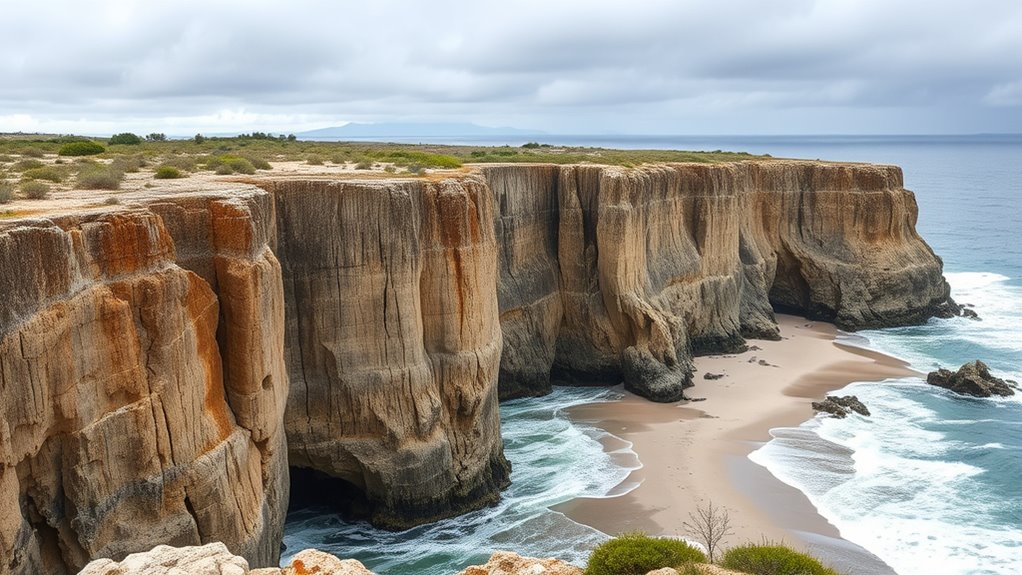
To effectively address the increasing erosion along Sardinia’s coasts, implementing thorough protection and resilience strategies is essential. You can support efforts by focusing on these key actions:
- Integrated Coastal Management: Work with Conservatoria delle Coste to promote sustainable beach management, restoring dunes like at Maria Pia beach to prevent erosion. The agency also coordinates initiatives that focus on areas susceptible to degradation, including ancient fishing villages and isolated locations. Incorporating craft and textiles techniques into local conservation efforts can enhance community engagement and support sustainable development.
- Multi-Stakeholder Initiatives: Engage local communities, businesses, and authorities through projects like COASTRUST to foster shared responsibility and adaptive management.
- Marine Protected Areas: Support the expansion and proper management of MPAs such as Isola Asinara, ensuring connectivity and habitat preservation to bolster ecosystem robustness.
Together, these strategies help protect Sardinia’s coastline from climate impacts, preserving its natural beauty and economic vitality.
Frequently Asked Questions
How Will Climate Change Affect Sardinia’S Freshwater Resources?
You’ll see climate change reducing Sardinia’s freshwater resources as decreasing rainfall and rising temperatures cause faster evaporation and soil drying. Droughts become more frequent and severe, depleting reservoirs and increasing saltwater intrusion into aquifers. This shortage impacts agriculture, ecosystems, and public health. Infrastructure struggles to keep up, leading to water rationing and increased competition for limited supplies, threatening livelihoods and biodiversity across the island.
What Are the Long-Term Social Impacts of Coastal Erosion on Local Communities?
You might see your community’s identity shift as coastal erosion forces homes and traditions to fade away. While tourism and fishing decline, social tensions grow over limited resources. As younger folks leave seeking jobs, aging populations face isolation. Infrastructure struggles to keep up with frequent storms, straining services. Ultimately, long-term, your community’s cohesion, economy, and way of life are at risk, with uncertain futures demanding urgent adaptation.
Can Natural Ecosystems Fully Adapt to Accelerated Sea-Level Rise?
You wonder if natural ecosystems can fully adapt to accelerated sea-level rise. While ecosystems like seagrass meadows and wetlands provide some buffering against erosion, they can’t keep up with rapid changes and extreme weather events. These natural defenses may weaken or fail over time, making it essential for you to support integrated solutions, combining ecosystems with engineering efforts, to enhance coastal resilience and protect biodiversity effectively.
How Effective Are Current Policies in Mitigating Sardinia’S Coastal Erosion?
You might see Sardinia’s policies as a sturdy ship steering stormy seas of erosion. While efforts like integrated management and ecological restoration act as protective shields, their effectiveness varies. Funding and community involvement strengthen the vessel, but long-term results remain uncertain without comprehensive impact studies. Ultimately, these policies offer hope, yet we need continuous monitoring and adaptive strategies to truly anchor coastal resilience against relentless erosion forces.
What Role Do Invasive Species Play in Altering Sardinian Marine Biodiversity?
Invasive species markedly alter Sardinian marine biodiversity by outcompeting native species for resources, introducing toxins, and preying on native fish and crustaceans. They create simplified habitats, reducing biodiversity and ecosystem resilience. You might notice declines in native populations and habitat changes, as these species spread via shipping, aquarium releases, and climate-driven range expansion. Their presence disrupts food webs and hampers the natural balance of Sardinia’s coastal ecosystems.
Conclusion
Remember, a chain is only as strong as its weakest link. As climate change accelerates, Sardinia’s coasts face rising seas, economic threats, and biodiversity loss. But with proactive strategies and community effort, you can help safeguard these valuable shores. Don’t wait until it’s too late—every action counts. Together, you can build resilience and ensure Sardinia’s coastline remains vibrant for generations to come. The future depends on what you do today.
